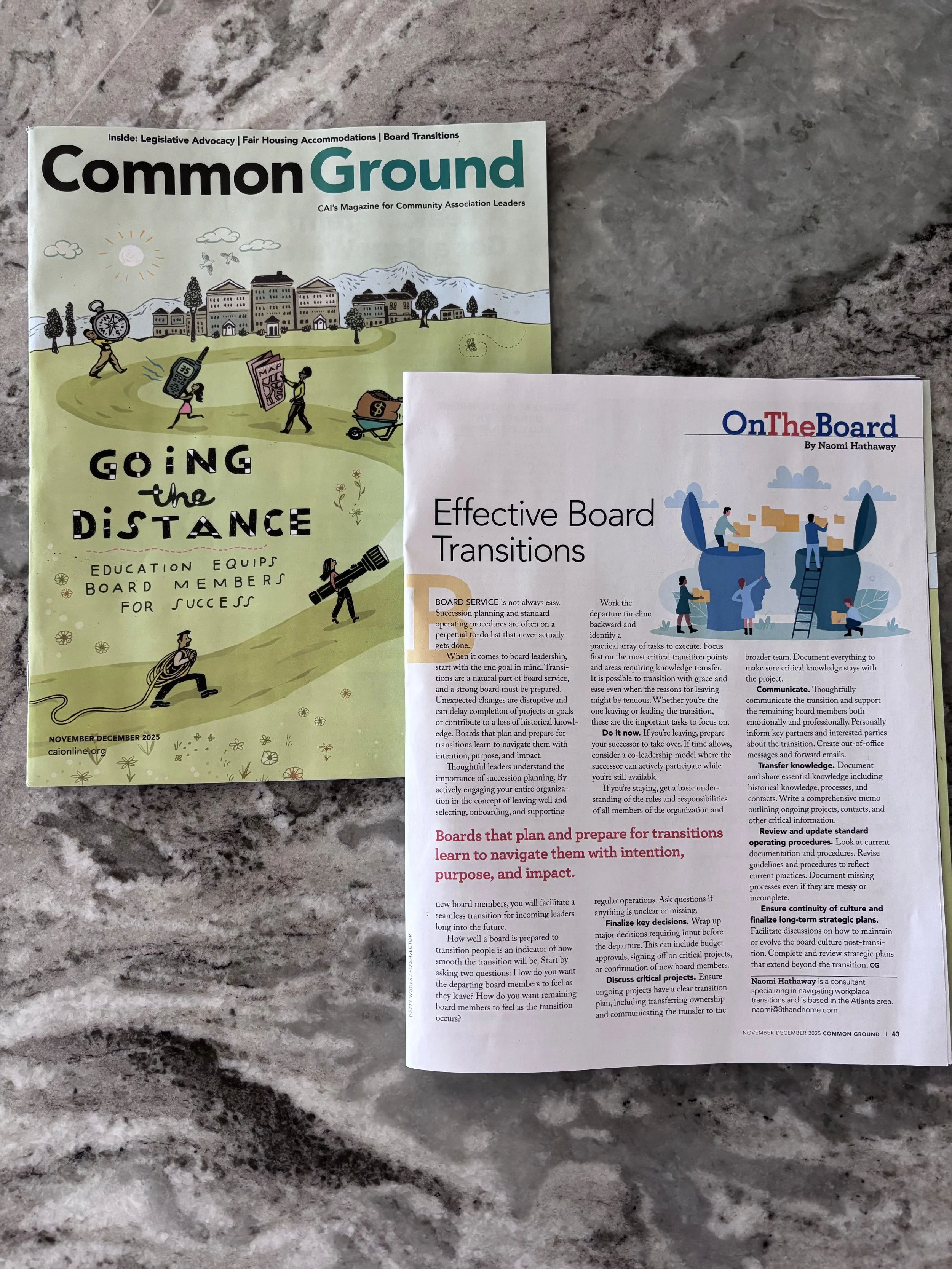Succession Planning Isn't Just for Nonprofits—It's for Any Organization That Depends on Leadership Transitions Going Smoothly
I recently published an article in Community Association Institute's magazine, Common Ground, about board succession planning for homeowners associations and community associations. The challenges I outlined for community association boards—perpetual to-do lists where succession planning never gets done, unexpected departures that derail operations, loss of institutional knowledge—these aren't unique to neighborhood governance. They're systemic across any organization that relies on volunteer or civic leadership.
Whether you're governing a condo association or a $5 million nonprofit, the fundamentals are the same: people leave, and if you're not prepared, the disruption ripples through everything you're trying to accomplish.
The Universal Problem
Community associations and nonprofit boards share more DNA than most people realize. Both operate with:
Volunteer leadership with finite terms
Limited time and competing priorities
Fiduciary responsibilities to a defined community
The need to maintain operational continuity despite leadership changes
Relationships with external stakeholders (vendors, funders, regulators, community partners)
In community associations, an unexpected board departure can delay critical building maintenance decisions, disrupt vendor negotiations, or create chaos in annual budget planning. In nonprofits, it can jeopardize funding relationships, stall program expansion, or compromise compliance requirements.
Different contexts. Same problem.
“The organizations that handle transitions well—whether they’re managing a 200-unit building or a community health center—understand one critical principle: succession planning isn’t about replacing people, it’s about protecting institutional knowledge and maintaining momentum.”
Why We Don't Do It
I've worked with enough boards to know why succession planning stays on the perpetual to-do list:
It feels theoretical. When everyone's present and engaged, planning for someone's departure seems like borrowing trouble. Until it's not theoretical anymore, and you have 30 days to transfer three years of vendor relationships.
It's uncomfortable. Talking about departures can feel like you're planning for failure or expressing lack of confidence in current leadership. In reality, it's the opposite—it's an acknowledgment that leadership is stewardship, not ownership.
It never feels urgent. There's always something more pressing. The budget needs approval. The grant deadline is next week. The complaint about the pool needs addressing. Succession planning can wait.
Except it can't.
The Cost of Not Planning
Here's what I've seen happen when organizations don't prioritize succession planning:
In a community association: The treasurer of seven years resigned with minimal notice. No one else on the board understood the reserve study, the vendor payment schedule, or which line items in the budget were restricted. The incoming treasurer spent six months just figuring out what questions to ask.
In a nonprofit: A board chair who had cultivated the organization's largest funder relationships stepped down. The personal connections she'd built over a decade weren't documented anywhere. The organization lost two major gifts the following year because no one knew to maintain those relationships.
These aren't dramatic failures. They're quiet erosions of organizational capacity. And they're entirely preventable.
Start with the End in Mind
When it comes to board leadership—nonprofit or community association—I start with the end in mind. Although it seems counterintuitive, the truth is people leave, and a strong board must be prepared for that.
Thoughtful leaders understand the importance of succession planning. By actively engaging your entire organization in the concept of leaving well—including the selection and onboarding of new board members—you create systems that facilitate seamless transitions.
The truth is, transitions are a natural part of board service. Intentional exits, such as when a board member terms out or resigns, are the ideal place to practice the art of Leaving Well. Without a clear transition plan, the remaining board may find themselves scrambling to cover responsibilities, maintain critical relationships, or simply keep operations moving forward.
How well a board is prepared to transition people is an indicator of how smooth the transition will be.
Start by asking these two questions:
How do you want the departing board member to feel as they leave?
How do you want the remaining board members to feel as the transition occurs?
From there, you can work the departure timeline backward, identifying practical tasks to be executed. Focus first on the most critical transition points and areas requiring knowledge transfer.
The Eisenhower Matrix for Board Transitions
The Eisenhower Matrix, popularized by Stephen Covey in 1989, is highly relevant to transition planning. I've adapted it for board transitions across volunteer organizations—whether community associations or nonprofits—helping prioritize tasks for smooth, intentional exits.
It is possible to transition with grace and ease—even when the reasons for leaving might be tenuous. Whether you're the one leaving or you're leading the remaining board through the transition, these are the important tasks to focus on.
Do It Now (Urgent-Important)
Succession Planning
If you're the one leaving: Prepare your successor to take over responsibilities. If time allows, consider a co-leadership model where the successor can actively participate in leadership responsibilities while you're still available.
If you're the one staying: Get a basic understanding of the roles and responsibilities of all board members and regular operations. Ask questions if anything is unclear or missing.
Finalize Key Decisions
Wrap up major decisions requiring input before the departure. For nonprofits, this might include budget approvals, signing off on critical projects, or confirmation of new board members. For community associations, it could be vendor contracts, capital improvement approvals, or assessment increases.
Critical Project Handover
Ensure ongoing projects have a clear transition plan, including transferring ownership and communicating the transfer to the broader team. Whether it's a capital campaign or a building renovation, documenting everything in a project plan ensures critical knowledge stays with the project, not just with the person.
Communication
Thoughtfully communicate the transition and support the remaining board members emotionally and professionally.
For nonprofits: Personally inform key funders, community partners, and program stakeholders about the transition.
For community associations: Notify residents, vendors, and property managers about leadership changes and new points of contact.
In both cases: Create out-of-office/forward email communications if not using a shared mailbox.
Future Planning (Not Urgent-Important)
Knowledge Transfer
Document and share essential knowledge with the board, including detailed documentation of institutional history, processes, and key relationships.
Write a comprehensive memo outlining ongoing projects, critical contacts (funders, vendors, regulators), compliance requirements, and other essential information for the successor. This is valuable whether you're handing off grant reporting schedules or special assessment timelines.
Review and Update Standard Operation Procedures (SOPs)
Take a look at what is currently documented and ask, "Is this how we are actually doing it?"
Revise guidelines and procedures to reflect current practices. Document processes that haven't been formalized, even if it's messy or incomplete. Real documentation beats perfect documentation that doesn't exist.
Ensure Continuity of Culture
Facilitate discussions on how to maintain or evolve the board culture post-transition. Whether it's your approach to community engagement or your philosophy on fiscal reserves, culture doesn't transfer automatically.
Finalize Long-term Strategic Plans
Complete and review strategic plans that extend beyond the transition. This includes multi-year capital plans, program expansion strategies, or community development initiatives.
The Organizations That Get It Right
The boards that navigate transitions well share common practices:
They treat succession planning as governance infrastructure, not crisis management. It's embedded in their operations, not something they scramble to address when someone announces their departure.
They document as they go. Every major decision includes a note about why it was made and what context future leaders need to know. Every key relationship has a contact record with history and next steps.
They create overlap periods. Incoming and outgoing leaders work together for a defined period, allowing real-time knowledge transfer instead of trying to capture everything in a memo.
They talk openly about transitions. The best boards I've worked with normalize the conversation about departures. They don't treat it as taboo or uncomfortable—they treat it as responsible stewardship.
What This Means for Your Board
If you're on a nonprofit board, you probably recognized your organization in this article. If you're on a community association board, same. That's the point.
The principles of leaving well transcend organizational type. They're rooted in a fundamental understanding that leadership is temporary, but the organization's mission is enduring.
Your job as a board member—whether you're ensuring residents have well-maintained common areas or ensuring a community has access to mental health services—is to set up the next person to succeed. That requires intentionality, documentation, and the willingness to plan for your own departure.
Most boards wait until someone announces they're leaving to think about succession. By then, you're in reactive mode. The organizations that thrive through transitions are the ones that build succession planning into their governance from day one.
The question isn't whether people will leave your board. They will.
The question is whether you'll be ready when they do.
To learn more about how to apply the Eisenhower Matrix for your board of directors, watch our explainer video here.


